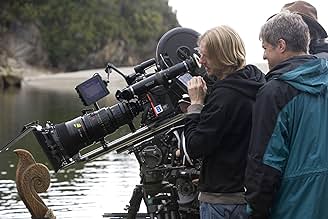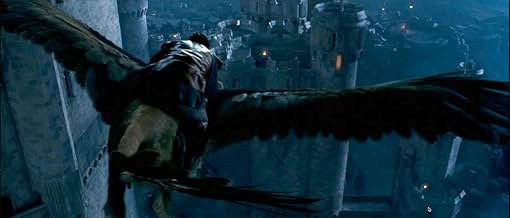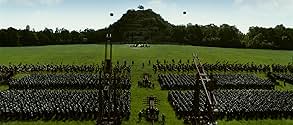The Pevensie siblings return to Narnia, where they are enlisted to once again help ward off an evil king and restore the rightful heir to the land's throne, Prince Caspian.The Pevensie siblings return to Narnia, where they are enlisted to once again help ward off an evil king and restore the rightful heir to the land's throne, Prince Caspian.The Pevensie siblings return to Narnia, where they are enlisted to once again help ward off an evil king and restore the rightful heir to the land's throne, Prince Caspian.
- Awards
- 4 wins & 21 nominations
Cornell John
- Glenstorm
- (as Cornell S. John)
Damián Alcázar
- Lord Sopespian
- (as Damian Alcazar)
Simón Andreu
- Lord Scythley
- (as Simon Andreu)
Predrag Bjelac
- Lord Donnon
- (as Pedja Bjelac)
Juan Diego Montoya
- Lord Montoya
- (as Juan Diego Montoya Garcia)
Storyline
Did you know
- TriviaTilda Swinton, as well as reprising her role as The White Witch, also makes a short cameo as a centaur.
- GoofsWhen the Pevensies are outside their treasure chamber in Cair Paravel, Peter tears off the entire bottom of his shirt, which would not have worked with a button down shirt because it splits in the middle, to make a makeshift torch. After Edmund takes out his flashlight, the camera once again shows Peter. The missing piece of his shirt is only on the right side. The rip changes again when they are entering the vault
- Quotes
King Miraz: Tell me, Prince Edmund...
Edmund Pevensie: King.
King Miraz: I beg your pardon.
Edmund Pevensie: It's King Edmund, actually. Just King, though. Peter's the High King.
[awkward pause]
Edmund Pevensie: I know, it's confusing.
- Alternate versionsThe original theatrical version of this film was released by Walt Disney Pictures, but all television, video, and theatrical re-issue versions of the film are distributed by 20th Century Fox. As a result, the current version in circulation opens with a 20th Century Fox logo. This happened as a result of Disney deciding against its distribution deal when it expired in 2010; Walden Media sold its share of the rights to 20th Century Fox that year.
- SoundtracksThe Call
Written by Regina Spektor
Arranged & Produced by Harry Gregson-Williams
Recorded & mixed by Peter Cobbin
Performed by Regina Spektor
Courtesy of Sire Records
Featured review
I came to this skeptically. I live in Virginia Beach where Pat Robertson's billion dollar film school is located. The idea is to blanket us with convincing fundamentalist propaganda. I am convinced that when they get better than their clumsy current efforts, we may be in for a rough ride. The Narnia books are in this same questionable class.
The first movie was an amazing surprise for me. Yes, it was the same tiresome stuff we have from a dozen other sources about children in mystical or magical contexts who save the world. Yes, it was aggressively allegorical, at the insistence of Lewis' wildeyed nephew who controls the rights. But it was subverted without the knowledge of those pinched faces. Tilda Swinton an intriguing person insisted on portraying her character in a certain way. This is the witch that is supposed to represent the evil, anti-Christian forces, but she played her as an Arian representing the abuse of religious argument. While the film itself was boring, her presence and her subversive activity, was wonderful. I'll bet they still don't know.
But she was to be absent here. And she was, except for one odd scene. So I came to this with some trepidation.
This is therefore more tedious than the first. All I could see was the stronger allegory of patriotic armies being led to mindless slaughter because of truculent leaders, and in the case of the "good guys" a young fellow who reminded me so much of the current US president. Its almost so obvious it seems deliberate. Perhaps there were many subversives on the set.
There's a strange plot goof here. These characters were supposed to have lived full lives and then be returned to children's bodies but with the wisdom of ages. Yet as the war actually approaches, they act precisely like children. Even at the end, the youngest is repelled by yucky kissing.
Here's something to look for if you do choose to see it. Its the character of the river.
The river is a physical boundary between the two races, and which is clearly supposed by Lewis to denote the transition between the real and magical worlds. Early in the story, our prince crosses it readily and his pursuers are stymied, pharaoh-wise. Shortly after, the first test of the children is to cross this same river, a test they fail because they did not follow Lucy, who alone lucidly sees Christ and is not believed. Later they accept her leadership across this river.
Meanwhile, the evil man is making a bridge to do the same with violent intent on the magical domain. The river literally becomes a character, called up by the Christ (actually a poet of Christ) and plays a decisive role in the ordained defeat. This should have been the central cinematic spine of the film. But alas, this filmmaker is poor, and we are left with shots through artificially clear water including one stock shot: of a small boat from below with the sun above. But its done so well, its worth it. And then we have the special effect of the rivergod rising in anger. This is actually a pretty good effect.
Ted's Evaluation -- 1 of 3: You can find something better to do with this part of your life.
The first movie was an amazing surprise for me. Yes, it was the same tiresome stuff we have from a dozen other sources about children in mystical or magical contexts who save the world. Yes, it was aggressively allegorical, at the insistence of Lewis' wildeyed nephew who controls the rights. But it was subverted without the knowledge of those pinched faces. Tilda Swinton an intriguing person insisted on portraying her character in a certain way. This is the witch that is supposed to represent the evil, anti-Christian forces, but she played her as an Arian representing the abuse of religious argument. While the film itself was boring, her presence and her subversive activity, was wonderful. I'll bet they still don't know.
But she was to be absent here. And she was, except for one odd scene. So I came to this with some trepidation.
This is therefore more tedious than the first. All I could see was the stronger allegory of patriotic armies being led to mindless slaughter because of truculent leaders, and in the case of the "good guys" a young fellow who reminded me so much of the current US president. Its almost so obvious it seems deliberate. Perhaps there were many subversives on the set.
There's a strange plot goof here. These characters were supposed to have lived full lives and then be returned to children's bodies but with the wisdom of ages. Yet as the war actually approaches, they act precisely like children. Even at the end, the youngest is repelled by yucky kissing.
Here's something to look for if you do choose to see it. Its the character of the river.
The river is a physical boundary between the two races, and which is clearly supposed by Lewis to denote the transition between the real and magical worlds. Early in the story, our prince crosses it readily and his pursuers are stymied, pharaoh-wise. Shortly after, the first test of the children is to cross this same river, a test they fail because they did not follow Lucy, who alone lucidly sees Christ and is not believed. Later they accept her leadership across this river.
Meanwhile, the evil man is making a bridge to do the same with violent intent on the magical domain. The river literally becomes a character, called up by the Christ (actually a poet of Christ) and plays a decisive role in the ordained defeat. This should have been the central cinematic spine of the film. But alas, this filmmaker is poor, and we are left with shots through artificially clear water including one stock shot: of a small boat from below with the sun above. But its done so well, its worth it. And then we have the special effect of the rivergod rising in anger. This is actually a pretty good effect.
Ted's Evaluation -- 1 of 3: You can find something better to do with this part of your life.
Details
- Release date
- Countries of origin
- Official sites
- Language
- Also known as
- Prince Caspian
- Filming locations
- Hereherataura Peninsula, Hahei, Coromandel, New Zealand(ruins of Cair Paravel)
- Production companies
- See more company credits at IMDbPro
Box office
- Budget
- $225,000,000 (estimated)
- Gross US & Canada
- $141,621,490
- Opening weekend US & Canada
- $55,034,805
- May 18, 2008
- Gross worldwide
- $419,665,568
- Runtime2 hours 30 minutes
- Color
- Sound mix
- Aspect ratio
- 2.39 : 1
Contribute to this page
Suggest an edit or add missing content
























